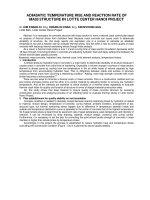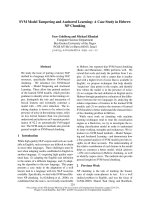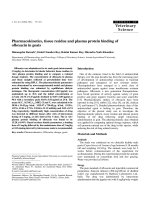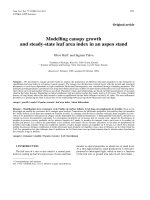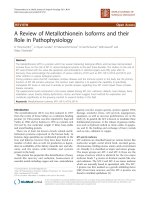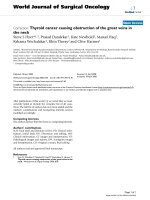Báo cáo khoa học: "Bench-to-bedside review: Genetics and proteomics: deciphering gene association studies in critical illness" pps
Bạn đang xem bản rút gọn của tài liệu. Xem và tải ngay bản đầy đủ của tài liệu tại đây (91.93 KB, 7 trang )
Page 1 of 7
(page number not for citation purposes)
Available online />Abstract
There is considerable interest in understanding genetic deter-
minants of critical illness to improve current risk stratification
models, provide individualized therapies, and improve our current
understanding of disease mechanisms. This review provides a
broad overview of genetic nomenclature, different study designs,
and problems unique to each of these study designs in critical
illnesses. Well designed genetic studies with careful attention to
these issues during the planning phase, use of rigorous statistical
methods during analysis, and replication of these results in
different cohorts will lead to more robust results and improved
understanding of genetics of critical care.
The completion of the Human Genome draft in 2000 has
been accompanied by an explosion of studies examining
genetic determinants of disease [1,2]. In critical care, current
prediction models based on socio-demographic and clinical
risk factors fail to explain fully why a particular patient either
develops or succumbs to disease. Consequently, physicians
have tried to understand if genetic variation affects
susceptibility and outcome of critical illnesses. Genetics may
also provide insights into biological mechanisms and allow
more precise use of interventions. Using targeted therapy
based on an individual’s genetic makeup, rather than using it
on all patients, is an appealing strategy. But conflicting
results from early studies in genetics of critical illness have
led the scientific community to view these results with
skepticism [3]. For example, there has been little consensus
regarding genetic markers associated with a tumor necrosis
factor (TNF) hypersecretor response. In particular, contra-
dictory reports have been published for the association
between the -308 guanine to adenine transition within the
promoter region of the TNF gene and its expression and
severe sepsis susceptibility [4,5]. This article will provide a
broad outline of study designs to ascertain the role of genetic
variation in critical care and focus on gene association
studies, the most common study design in critical care. The
article also addresses both problems generic to genetic
studies and those unique to genetics of critical illness.
Mendelian and complex traits
Mendelian traits or diseases, such as sickle cell disease or
cystic fibrosis, are influenced by a single gene. In contrast,
most critical illnesses are multifactorial diseases, and called
‘complex traits’ in genetic parlance. Severe sepsis, an
example of a complex trait, results from multiple etiologies,
such as Gram-positive and Gram-negative bacteria, or fungal
infections. The progression to severe sepsis is often
mediated by a common biological pathway, with variations
unique to specific infectious agents. Therefore, genetic
variations within inflammatory mediators involved in the sepsis
pathway have been hypothesized to play a role [4,6,7].
However, in addition to genetic factors, host characteristics
and pathogen load also influence the phenotype. The relative
contribution of host genetic factors in complex traits like
severe sepsis would be modest.
Focusing only on the contribution of genetic variation to
disease, the exact pattern of genetic variation influencing
complex traits is still unclear and several theories have been
proposed [8]. One model, termed the common disease-rare
variant model, suggests that phenotypic variation in complex
traits is due to numerous rare genetic variants at multiple loci,
with each variant single handedly causing disease. Although
the frequency of each rare variant is low, populations may
have several such variants. An example of the common
disease-rare variant model includes mutations in the BRCA1
and BRCA2 genes, which have been implicated in the
susceptibility to breast and ovarian cancer [9]. The frequency
Review
Bench-to-bedside review: Genetics and proteomics: deciphering
gene association studies in critical illness
Sachin Yende
1
, Candace M Kammerer
2
and Derek C Angus
1
1
The CRISMA (Clinical Research, Investigation, and Systems Modeling of Acute Illness) Laboratory, Department of Critical Care Medicine, University of
Pittsburgh, Pittsburgh, PA, USA
2
Department of Human Genetics, University of Pittsburgh, PA, USA
Corresponding author: Sachin Yende,
Published: 24 August 2006 Critical Care 2006, 10:227 (doi:10.1186/cc5015)
This article is online at />© 2006 BioMed Central Ltd
ARDS = adult respiratory distress syndrome; IL = interleukin; LD = linkage disequilibrium; SNP = single nucleotide polymorphism; TNF = tumor
necrosis factor.
Page 2 of 7
(page number not for citation purposes)
Critical Care Vol 10 No 4 Yende et al.
of each of the four mutations within these genes is less than
5%, but more than 80% of subjects with these mutations
develop breast cancer.
In contrast, the common disease-common variant model
suggests that common variants underlie complex traits. Such
variants may be maintained through generations due to some
form of balancing selection, where the same genetic variant
may be protective for certain diseases and harmful in others.
This model may be particularly important in critical illnesses,
which often occur due to differences in expression of
inflammatory mediators. A robust pro-inflammatory response
with TNF and IL-6 release may increase the risk of
complications, such as severe sepsis or adult respiratory
distress syndrome (ARDS), yet that same response may be
critical for an adequate host response to infection. Therefore,
genetic variants associated with a pro-inflammatory response
could be protective and detrimental under different conditions.
An example of balancing selection is the guanine to adenine
transition at the +250 site within the lymphotoxin alpha gene,
which is associated with increased TNF expression and also
with higher risk of severe sepsis but lower risk of prolonged
mechanical ventilation after coronary artery bypass graft
surgery [4,10]. Complex traits may also occur due to a
combination of rare and common variants. Finally, interactions
may occur among genes (epistasis) and with environmental
factors (gene-environment interactions) to influence the
phenotype (Table 1).
Nomenclature: polymorphism, mutation, and
SNPs
Nucleotides are the building blocks of DNA and contain one
of the following four bases: adenine (A), thymine (T), guanine
(G), or cytosine (C). A polymorphism is a common variation in
the sequence of DNA among individuals (>1% of the
population). Substitution of one of the four base pairs by
another base pair is called single nucleotide polymorphism or
SNP; for example, a SNP may change the DNA sequence
from AATCG to AGTCG. Mutations are also heritable
changes in the DNA sequence, but have a frequency of <1%.
Polymorphisms occur at a rate higher than can be explained
by new mutations, suggesting that they may confer some
survival advantage. Variable number of tandem repeats is
another type of polymorphism, where a particular repetitive
sequence is present in different numbers in different
individuals. An example of a tandem repeat is the
tetranucleotide (CATT)
n
repeat within the promoter region of
the macrophage inhibitory factor gene, where subjects can
have from five to eight repeats [11].
All SNPs are not the same: choosing
candidate SNPs
The genes in the human genome account for a very small
fraction of the total DNA, and more than 90% of the
sequences between genes do not encode any particular
product [12]. Variations within DNA are ubiquitous. SNPs
occur every 1,000 base pairs in the human genome, and
most SNPs do not lead to a change in protein structure or
secretion. When SNPs lead to changes in amino acids they
are called non-synonymous or missense SNPs. Some of the
non-synonymous SNPs in the coding region may affect
protein structure and lead to alterations in phenotype. An
example is the G to A coding polymorphism at the +1691
site in the factor V gene of the coagulation cascade [13]. This
polymorphism leads to the substitution of an arginine by
glutamine at amino acid position 506, which is one of the
cleavage sites for activated protein C. Factor V inactivation is
delayed because the cleavage site is not present, and leads
to a hypercoagulable state.
Similar to non-synonymous SNPs, those in the promoter
region are also important. Although they do not affect protein
structure, they may affect binding of transcription factors and
alter expression of the protein in response to an appropriate
stimulus. For example, an insertion/deletion polymorphism,
termed 4G/5G, is found 675 base pairs upstream of the trans-
criptional initiation site in the plasminogen activator inhibitor-1
gene [14,15]. Although both alleles bind a transcriptional
activator, the 5G allele reduces transcription by binding a
repressor protein, and is associated with lower circulating
plasminogen activator inhibitor-1 concentrations [16,17].
However, most SNPs have no effect on the phenotype
because they are either in non-coding regions or they are
synonymous SNPs, which are variants that code for the same
amino acid. Of the SNPs in the non-coding region, those in
the 5′ or 3′ untranslated region are probably more important
than those in introns, which are non-coding sequences of
DNA that are initially copied into the RNA but cut out of the
final RNA transcript. They may play critical roles in the post-
transcriptional regulation of gene expression, including
modulation of the transport of mRNAs out of the nucleus and
stabilization of protein [18]. It is important to understand
these distinctions when choosing SNPs during candidate
gene analysis for causal variants. In general, promoter region
and non-synonymous SNPs are likely to be more important
than those in the non-coding region.
SNPs are not necessarily causal: role of
genetic markers, linkage disequilibrium, and
haplotype blocks
Knowing the causal SNP may often be difficult. Often, we
may discover a SNP ‘associated’ with a specific phenotype,
but it is simply a ‘marker’ rather than the causal variant. This
marker is co-inherited along with the causal variant because it
tends to be on the same piece of DNA. This phenomenon
where two genetic variants are inherited together through
generations is called linkage disequilibrium (LD). Several
methods can be used to measure LD. Two most commonly
used are Lewontin D’ and R
2
. Both are measures of
correlation and expressed on a scale of 0 to 1, with a higher
number indicating greater LD or that these SNPs are more
Page 3 of 7
(page number not for citation purposes)
likely to be inherited together. These measures of LD are
statistical measurements in population genetics and do not
necessarily imply distance between the two sites. LD maps
for SNPs within a single gene are available publicly and
provide important insights into choosing marker SNPs for
candidate gene analysis.
LD is a powerful tool in genetics. During meiosis, pieces of
maternal and paternal DNA are exchanged via recombination.
However, markers in LD remain tightly linked and are
transmitted through generations as regions of DNA called
haplotype blocks. Once an association is determined between
a marker and disease, one could focus on the ‘block’ of DNA
to identify the causal polymorphism. These ‘blocks’ can be
identified, or tagged, by one or more polymorphisms on the
block. Once a haplotype of interest has been described,
additional work can be done to sequence the haplotype and
tease out the specific functional polymorphism within the
haplotype that appears to cause the phenotype.
Haplotype and haplotype tag SNPs
Haplotyping is a way of describing blocks of DNA with a
pattern of alleles. A potential problem in constructing
haplotypes from results of genotype alone is that it is often
difficult to determine which set of alleles derives from the
paternal chromosome and which set derives from the
maternal chromosome. In other words, how are adjacent
bases aligned on each chromosome? The specific arrange-
ment of markers on each chromosome within a pair is called
haplotype phase. Although phase can be determined by
molecular genetic techniques, such methods are expensive.
Therefore, statistical software is used to estimate the
haplotype frequencies in a population based on genotype
data and LD.
Commonly used statistical programs either use iterative
likelihood (SAS Genetics, EH Plus) or Bayesian methods
(PHASE) to estimate haplotype frequencies in the population.
Consider an example of estimation of haplotypes and
frequencies of each of these haplotypes in the promoter
region of the TNF gene with two SNPs at the -308 and -238
sites (Figure 1). Based on arrangement of these alleles on the
maternal and paternal chromosomes, an individual with a GA
genotype at both sites could potentially have four different
haplotypes, G/G, G/A, A/G, and A/A. Assuming that no LD
exists between these sites, the probability of each of these
haplotypes is 0.25. However, the estimated probabilities
based on LD differ significantly. It is important to emphasize
that statistical methods can only estimate probabilities of
each haplotype.
Available online />Table 1
Nomenclature and explanation of some terms in genetic epidemiology
Term Explanation
Allele Alternative form of gene
Epistasis The interaction of two or more genes to influence a single phenotype
Exon Part of the DNA that contains the code for producing the gene’s protein
Haplotypes Closely related variants that are inherited as a unit
Haplotype phase Determination of which of the two chromosomes a series of markers or SNPs are present on
Intron A non-coding sequence of DNA that is initially copied into the RNA, but is cut out of the final RNA
transcript
Linkage disequilibrium Non-random association of alleles at linked loci
Mutation Change in DNA sequence with frequency ≤1%
Non-synonymous or missense SNPs SNPs that are associated with change in amino acid in the transcribed protein
Polymorphism Variation in DNA with frequency >1%
Recombination Maternal and paternal chromosomes pair up and exchange segments of DNA in germ cells
Single nucleotide polymorphism (SNP) Common, but minute variations in the DNA sequence
Synonymous SNPs SNPs that are not associated with change in amino acid in the transcribed protein
Tag SNPs There is a degree of redundancy when SNPs are in linkage disequilibrium with each other within a
haplotype. A single or a group of SNPs can be used to identify the entire haplotype block and is
called tag SNP
Transmission disequilibrium test A family based study design using parents-affected child trios. This design tests for an association
between a specific allele and disease in the child by testing whether heterozygous parents transmit
this allele to affected children more frequently than expected
The human chromosome is a mosaic of several such
haplotype blocks, which are often 11 to 22 kb in size, but may
extend longer [19]. Although multiple polymorphisms (SNPs
or variable number of tandem repeats) may be present on
each haplotype block, only two or three of them are required
to identify a particular haplotype. These SNPs are called
haplotype tag SNPs, and are often used as genetic markers
in gene association studies. Haplotype tag SNPs are an
important tool in mapping genetic determinants of disease
and, therefore, there is much interest in developing a
haplotype map of the entire human genome [20,21].
Study design
Two broad approaches are used to assess the roles of
genetic variants in disease: linkage analysis and association
studies (Figure 2). Linkage analysis follows meiotic events
through families for co-segregation of disease and genetic
variants. In contrast to chronic illnesses like diabetes,
obtaining an accurate family history about critical illnesses in
the past, such as whether a family member developed ARDS
after pneumonia, is difficult. Therefore, this approach is less
useful in acute illnesses, and has not been used widely in the
critically ill. In contrast to linkage analysis, association studies
detect association between genetic variants and disease
across individuals in large populations. Most association
studies are population based, but family based studies using
parents-affected child trios (transmission disequilibrium test)
can also be conducted. This design tests for an association
between a specific allele and disease in the child by testing
whether heterozygous parents transmit this allele to affected
children more frequently than expected [22].
Gene association studies can be cohort or case-control.
Cohort studies are time consuming and expensive to
conduct, and are impractical for rare diseases, whereas case-
control designs can be affected by selection bias or
information bias. However, there are study design problems
unique to gene-association studies in critical care. A common
practice in case control studies is the use of blood bank
donors as a control population. For example, consider a case-
control design to study genetic variants influencing
susceptibility to pneumonia and severe sepsis. The allele
frequency in the control population is often driven by subjects
who volunteer to participate in the control group. Little
information is available on whether individuals in the control
group would or would not develop pneumonia when exposed
to an adequate pathogen load in the presence of similar non-
genetic risk factors for pneumonia susceptibility.
Even assuming that pneumonia does occur uniformly in the
controls and cases, it is not known if severe sepsis would
then develop among controls. Severe sepsis and other
Critical Care Vol 10 No 4 Yende et al.
Page 4 of 7
(page number not for citation purposes)
Figure 1
Estimation of haplotype frequencies for two tumor necrosis factor (TNF) single nucleotide polymorphisms (SNPs) at -308 and -238 promoter sites.
Two SNPs are in linkage disequilibrium at -308 and -238
sites within the promoter region of the TNF gene. The frequency
of rare allele A at -308 and -238 sites is 0.15 and 0.05, respectively
Assuming random
arrangement of the alleles,
four possible combinations are
possible with equal probability
-238 G A G A -238 G A G A
-308 G G A A -308 G G A A
25% 25% 25% 25% 80% 15% 5% 0%
Estimated probability of each
combination or haplotype
assuming linkage
disequilibrium
Figure 2
Overview of genetic studies.
critical illnesses often occur due to differences in innate
immune response. Therefore, while a particular innate immune
response like higher TNF production can be protective for
pneumonia susceptibility, it might increase risk of severe
sepsis. Critical illness occurs in the continuum of a healthy
host, who develops infection or trauma, progresses to organ
dysfunction or severe sepsis, and death. Taking only the cases
at the end of this spectrum, those with established severe
sepsis, and comparing them to healthy blood donors could be
an entirely spurious process. This association could be
confounded by the inciting stimulus that led to severe sepsis.
An inception cohort design is thus a stronger approach. But
such studies are time consuming and it is impractical to
follow large population based cohorts for long periods,
waiting for infections and critical illness to occur. One must,
therefore, identify a population at risk, and a single inception
cohort may not be able to provide all the answers. One
example would be to follow a cohort of elderly subjects for
development of pneumonia, while another inception cohort of
subjects who present to physicians’ offices or emergency
rooms with pneumonia could be followed for development of
subsequent complications.
Finally, gene-environment interactions are also important to
consider in gene association studies. Many interventions in
the intensive care unit alter the cytokine cascade, such as
strategies to ventilate patients, medications, or surgical
techniques. Since differences in expression of proteins
involved in the cytokine cascade are hypothesized as
candidate genes, interactions between cytokine gene
polymorphisms and these interventions would be important.
Candidate gene approach and genome-wide
screen
Regardless of the overall study design, one also needs to
decide what methodology to use to examine genetic variation.
There are two general approaches: genome-wide association
studies and candidate gene association studies. Genome-wide
association studies are philosophically similar to whole genome
linkage analyses, where the investigator does not have an a
priori idea of the susceptibility locus, but is trying to locate a
chromosomal region that is associated with the ‘disease’ of
interest [23]. This approach is hypothesis-generating, and it is
technologically intensive and expensive. However, as the cost
of genotyping continues to decrease, this methodology
becomes more viable. The exact number of SNPs and type of
SNPs (all versus non-synonymous SNPs only) to be used for a
genome-wide screen is still a matter of debate.
The candidate gene approach examines the role of genetic
variation in one or more genes most likely to be involved in
the biological pathway. This approach requires an
understanding of the biological mechanisms to identify
candidate genes and is commonly used because it is
technologically non-intensive and relatively inexpensive.
Alternatively, a hybrid approach can be used: a genome-wide
screen is used to identify genetic variation spaced throughout
the human genome, followed by a candidate gene approach
to examine genes within the region of interest.
Phenotype
Accurate definition of phenotype is critical to genetic studies.
False positive or false negative results are often due to
differences in definitions of phenotypes across studies.
Critical illnesses are heterogeneous conditions or syndromes
and occur due to a variety of etiologies, each leading to
different outcomes. Although clinical definitions of ARDS or
severe sepsis are useful diagnostic criteria for clinicians, they
may be too expansive for understanding the role of genetic
variation. Different sets of genetic markers may underlie
susceptibility to ARDS due to infections and trauma [24].
Similarly, genetic variation underlying severe sepsis susceptibility
due to different infections may also vary due to interactions
between individual organisms and genetic variants.
Statistical issues in gene association studies
Power
Irrespective of study design, it is critical to have sufficient
power to detect association. As described previously, the
relative risk for critical illness for individual loci would be
small, with relative risk ≤ 2. Sample size estimates for gene
association studies are determined by the allele frequency
and relative risk of the genetic marker of interest. In general,
association studies may be more likely to provide statistical
evidence of a disease gene with low relative risks than
linkage studies [25]. However, approximately 1,000 cases
and 1,000 controls will be required to detect modest relative
risks of 1.5 [26]. Larger sample sizes would be necessary for
rare alleles (frequency <10%), whereas smaller sample sizes
would be required if the relative risks are larger. Numerous
statistical tools are available to determine sample sizes
required for different levels of significance, for example
Quanto [22,27] and Genetic Power Calculator [28,29].
Multiple testing
There is no easy statistical solution to the problem of multiple-
testing. If thousands of tests are performed, then there will be
many false-positive results. One of the current approaches is
to use a false-discovery rate (FDR) statistic to decide what
proportion of true positives to false positives is acceptable to
the investigator, choose a level of significance based on this
proportion, and follow-up on all results that achieve this level
of significance [30]. Thus, the first stage of analyses in which
multiple-testing is performed is usually considered to be
hypothesis-generating, and results of these analyses will
contain some false positives. However, follow-up analyses in
another population, that is, replication, should differentiate
between true-positive and false-positive results.
Increasingly, the use of permutation tests is being advocated
to estimate p-values. P-values for genotype or haplotypes are
Available online />Page 5 of 7
(page number not for citation purposes)
calculated by random permutations thousands of times. The
resulting empirical distribution is used to estimate the p-value
for the test-statistic obtained from the actual data. Permutation
analyses will account for some of the relatedness among the
markers, which are linked if present on the same chromosome.
This will remove the dependence of the test-statistic on an
underlying distribution. Several statistical packages like R
Statistical Computing Environment [31] and SAS Genetics
enable the estimation of permutation statistics and FDR.
Replication of genetic studies
The strongest evidence that a particular variant or candidate
gene is associated with a trait, and thus may be causal, or in
strong LD with a causal variant, is to replicate the result [32].
Replication is defined as doing the analyses in a different
population, preferably by different investigators, using
different methods to avoid introduction of bias. DeMeo and
colleagues [33] recently used linkage analysis to narrow
down the candidate genes for chronic obstructive pulmonary
disease to chromosome 2q. Using microarray technology on
murine and human lung tissue, they identified three genes of
interest on chromosome 2q. The associations between these
three genes and chronic obstructive pulmonary disease were
tested using family based design, and the association with
one of the genes, a serine protease inhibitor or SERPINE2,
was confirmed in another case-control design using different
patient populations from the United States.
Studies have attempted to replicate work in populations of
different ethnic origin. For example, a recent report showed
that the association between polymorphisms within the
selenoprotein S gene with TNF and IL-6 expression in a study
of Caucasians was replicated among Mexican families [34].
However, failure to replicate results for a genetic marker in
populations of different ethnic origin does not suggest that
the results are merely due to type I error. Rather, differences
in LD between the genetic marker and the causal variant may
lead to different results.
Population admixture
Sub-populations within a population may have a different
genetic architecture. Differences in frequency of genetic
variants within the population may lead to false positive
results. False positive associations between genetic markers
and disease can occur due to association of disease with a
sub-population, rather than the genetic marker. Self-reported
race is used commonly to stratify subjects to avoid ethnic
stratification. Population admixture is more common among
self-identified African-American subjects compared to those
identifying themselves as of Caucasian ethnic origin [35].
Although population admixture does occur in most genetic
association studies, the extent to which results would be
affected is less clear. Techniques have been developed to
detect and correct for population stratification by typing
unlinked markers [36-38]. Whether this approach is
adequate is controversial [39].
Conclusion
Genetic association studies will be more valid if study design
issues are carefully considered during the planning phase of
a study and rigorous statistical methods are used during
analysis. There are several challenges to conducting well
designed genetic studies in critical care, including recruiting
large cohorts to obtain sufficient power, accurately identifying
phenotypes, identifying appropriate case and control groups,
and choosing a candidate gene or whole genome approach.
However, if such considerations are met, one can be
cautiously optimistic that genetic association studies may
lead to better understanding of biological mechanisms and
improve our ability to target therapy in the critically ill.
Competing interests
The authors declare that they have no competing interests.
Acknowledgements
Drs Yende and Angus are supported by NIGMS R01 GM61992.
References
1. Lander ES, Linton LM, Birren B, Nusbaum C, Zody MC, Baldwin J,
Devon K, Dewar K, Doyle M, FitzHugh W, et al.: Initial sequencing
and analysis of the human genome. Nature 2001, 409:860-921.
2. Venter JC, Adams MD, Myers EW, Li PW, Mural RJ, Sutton GG,
Smith HO, Yandell M, Evans CA, Holt RA, et al.: The sequence
of the human genome. Science 2001, 291:1304-1351.
3. Weiss KM, Terwilliger JD: How many diseases does it take to
map a gene with SNPs? Nat Genet 2000, 26:151-157.
4. Mira JP, Cariou A, Grall F, Delclaux C, Losser MR, Heshmati F,
Cheval C, Monchi M, Teboul JL, Riche F, et al.: Association of
TNF2, a TNF-a promoter polymorphism, with septic shock
susceptibility and mortality. JAMA 1999, 282:561-568.
5. Stuber F, Udalova IA, Book M, Drutskaya LN, Kuprash DV, Turet-
skaya RL, Schade FU, Nedospasov SA: -308 tumor necrosis
factor (TNF) polymorphism is not associated with survival in
severe sepsis and is unrelated to lipopolysaccharide
inducibility of the human TNF promoter. J Inflamm 1995, 46:
42-50.
6. Gallagher PM, Lowe G, Fitzgerald T, Bella A, Greene CM, McEl-
vaney NG, O’Neill SJ: Association of IL-10 polymorphism with
severity of illness in community acquired pneumonia. Thorax
2003, 58:154-156.
7. Waterer GW, Quasney MW, Cantor RM, Wunderink RG: Septic
shock and respiratory failure in community-acquired pneumo-
nia have different TNF polymorphism associations. Am J
Respir Crit Care Med 2001, 163:1599-1604.
8. Zwick ME, Cutler DJ, Chakravarti A: Patterns of genetic varia-
tion in Mendelian and complex traits. Annu Rev Genomics
Hum Genet 2000, 1:387-407.
9. King MC, Marks JH, Mandell JB: Breast and ovarian cancer
risks due to inherited mutations in BRCA1 and BRCA2.
Science 2003, 302:643-646.
10. Yende S, Quasney MW, Tolley E, Zhang Q, Wunderink RG:
Association of tumor necrosis factor gene polymorphisms
and prolonged mechanical ventilation after coronary artery
bypass surgery. Crit Care Med 2003, 31:133-140.
Critical Care Vol 10 No 4 Yende et al.
Page 6 of 7
(page number not for citation purposes)
This article is part of a thematic series on
Translational Research
edited by John Kellum.
Other articles in the series can be found online at,
/>theme-series.asp?series=CC_Trans
11. Donn RP, Shelley E, Ollier WE, Thomson W: A novel 5
′′
-flanking
region polymorphism of macrophage migration inhibitory
factor is associated with systemic-onset juvenile idiopathic
arthritis. Arthritis Rheum 2001, 44:1782-1785.
12. Stein LD: Human genome End of the beginning. Nature 2004,
431:915-916.
13. Bertina RM, Koeleman BPC, Koster T, Rosendaal FR, Dirven RJ,
de Ronde H, van der Velden PA, Reitsma PH: Mutation in blood
coagulation factor V associated with resistance to activated
protein C. Nature 1994, 369:64-67.
14. Dawson SJ, Wiman B, Hamsten A, Green F, Humphries S,
Henney AM: The two allele sequences of a common polymor-
phism in the promoter of the plasminogen activator inhibitor-
1 (PAI-1) gene respond differently to interleukin-1 in HepG2
cells. J Biol Chem 1993, 268:10739-10745.
15. Eriksson P, Kallin B, ‘t Hooft FM, Bavenholm P, Hamsten A:
Allele-specific increase in basal transcription of the plasmino-
gen-activator inhibitor 1 gene is associated with myocardial
infarction. Proc Natl Acad Sci USA 1995, 92:1851-1855.
16. Westendorp RG, Hottenga JJ, Slagboom PE: Variation in plas-
minogen-activator-inhibitor-1 gene and risk of meningococcal
septic shock. Lancet 1999, 354:561-563.
17. Hermans PW, Hibberd ML, Booy R, Daramola O, Hazelzet JA, de
Groot R, Levin M: 4G/5G promoter polymorphism in the plas-
minogen-activator-inhibitor-1 gene and outcome of meningo-
coccal disease. Meningococcal Research Group. Lancet 1999,
354:556-560.
18. Mignone F, Gissi C, Liuni S, Pesole G: Untranslated regions of
mRNAs. Genome Biol 2002, 3:reviews0004.
19. Gabriel SB, Schaffner SF, Nguyen H, Moore JM, Roy J, Blumen-
stiel B, Higgins J, DeFelice M, Lochner A, Faggart M, et al.: The
structure of haplotype blocks in the human genome. Science
2002, 296:2225-2229.
20. The International HapMap Consortium: A haplotype map of the
human genome. Nature 2005, 437:1299-1320.
21. International HapMap Project [www.hapmap.org]
22. Gauderman WJ: Candidate gene association analysis for a
quantitative trait, using parent-offspring trios. Genet Epidemiol
2003, 25:327-338.
23. Hirschhorn JN, Daly MJ: Genome-wide association studies for
common diseases and complex traits. Nat Rev Genet 2005, 6:
95-108.
24. Lin Z, Pearson C, Chinchilli V, Pietschmann SM, Luo J, Pison U,
Floros J: Polymorphisms of human SP-A, SP-B, and SP-D
genes: association of SP-B Thr131Ile with ARDS. Clin Genet
2000, 58:181-191.
25. Risch NJ: Searching for genetic determinants in the new mil-
lennium. Nature 2000, 405:847-856.
26. Reich D, Patterson N, Jager PLD, McDonald GJ, Waliszewska A,
Tandon A, Lincoln RR, DeLoa C, Fruhan SA, Cabre P, et al.: A
whole-genome admixture scan finds a candidate locus for mul-
tiple sclerosis susceptibility. Nat Genet 2005, 37:1113-1118.
27. Quanto [ />28. Purcell S, Cherny SS, Sham PC: Genetic Power Calculator:
design of linkage and association genetic mapping studies of
complex traits. Bioinformatics 2003, 19:149-150.
29. Genetic Power Calculator [ />gpc/]
30. Hochberg Y, Benjamini Y: More powerful procedures for multi-
ple significance testing. Stat Med 1990, 9:811-818.
31. R Statistical Computing Environment [ />32. de Bakker PIW, Yelensky R, Pe’er I, Gabriel SB, Daly MJ, Altshuler
D: Efficiency and power in genetic association studies. Nat
Genet 2005, 37:1217-1223.
33. DeMeo DL, Mariani TJ, Lange C, Srisuma S, Litonjua AA, Celedon
JC, Lake SL, Reilly JJ, Chapman HA, Mecham BH, et al.: The
SERPINE2 gene is associated with chronic obstructive pul-
monary disease. Am J Hum Genet 2006, 78:253-264.
34. Curran JE, Jowett JBM, Elliott KS, Gao Y, Gluschenko K, Wang J,
Azim DMA, Cai G, Mahaney MC, Comuzzie AG, et al.: Genetic
variation in selenoprotein S influences inflammatory
response. Nat Genet 2005, 37:1234-1241.
35. Sinha M, Larkin EK, Elston RC, Redline S: Self-reported race
and genetic admixture. New Engl J Med 2006, 354:421-422.
36. Pritchard JK, Stephens M, Rosenberg NA, Donnelly P: Association
mapping in structured populations. Am J Hum Genet 2000,
67:170-181.
37. Ardlie KG, Lunetta KL, Seielstad M: Testing for population sub-
division and association in four case-control studies. Am J
Hum Genet 2002, 71:304-311.
38. Freedman ML, Reich D, Penney KL, McDonald GJ, Mignault AA,
Patterson N, Gabriel SB, Topol EJ, Smoller JW, Pato CN, et al.:
Assessing the impact of population stratification on genetic
association studies. Nat Genet 2004, 36:388-393.
39. Cardon LR, Palmer LJ: Population stratification and spurious
allelic association. Lancet 2003, 361:598-604.
Available online />Page 7 of 7
(page number not for citation purposes)
